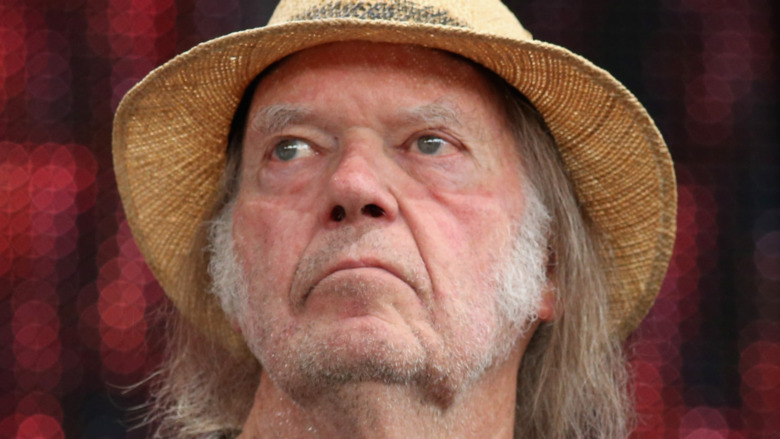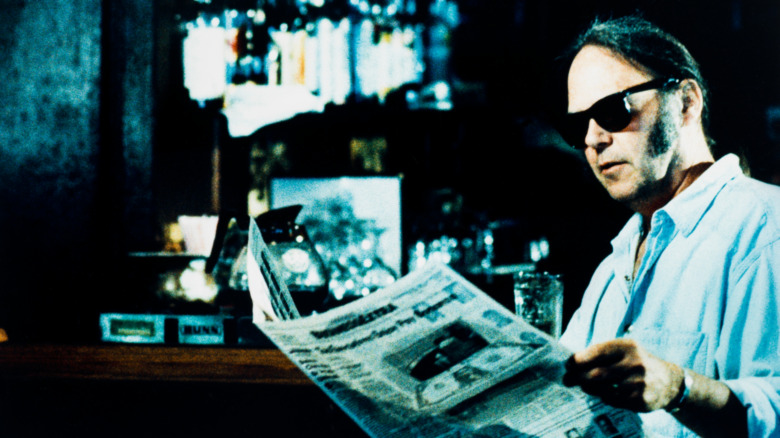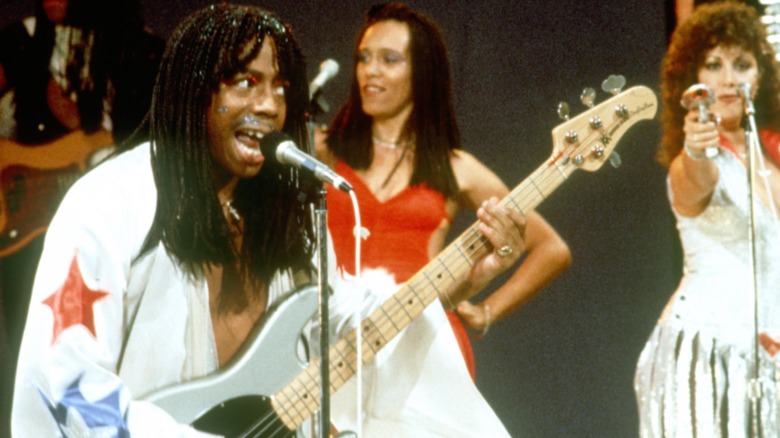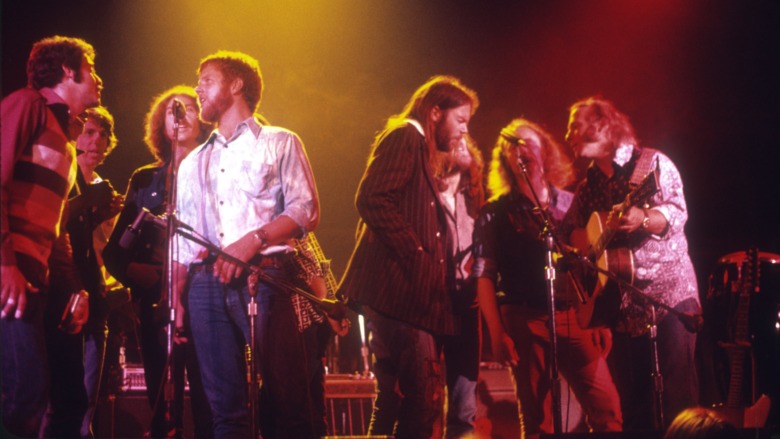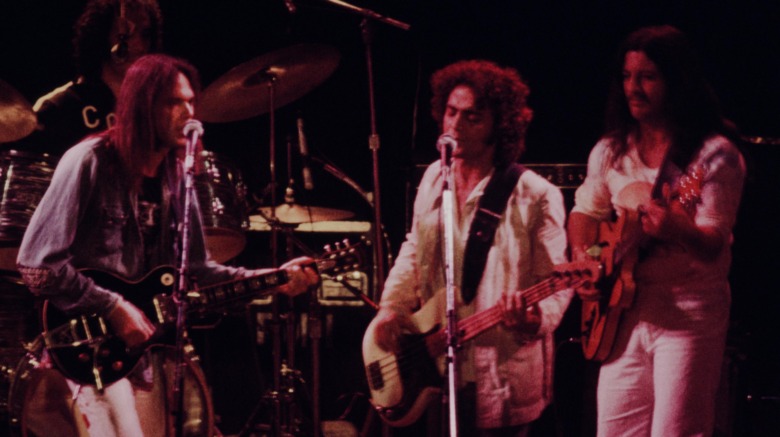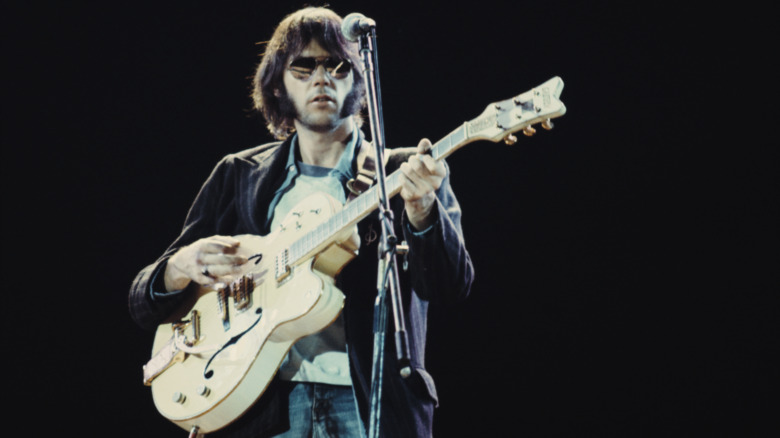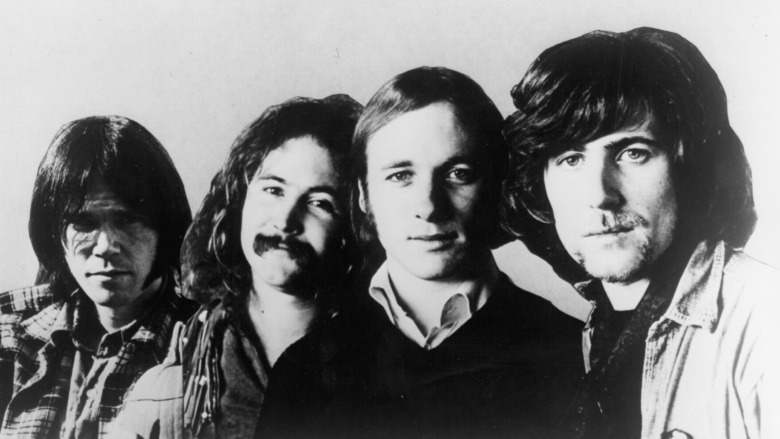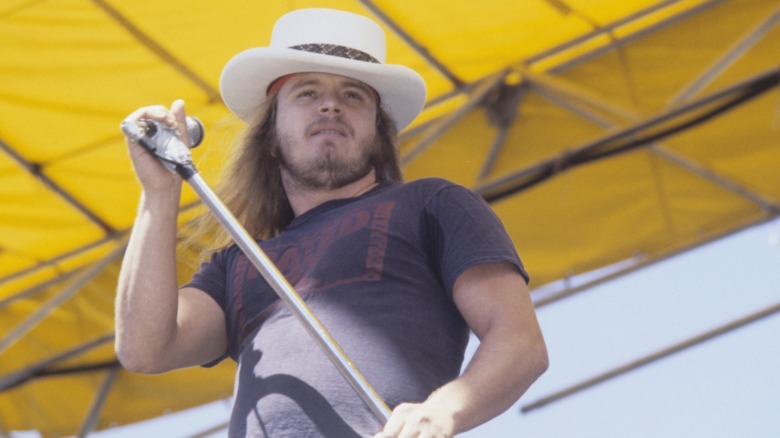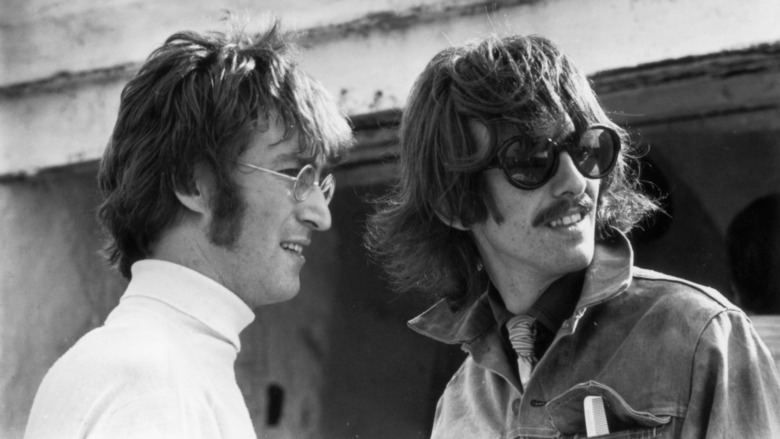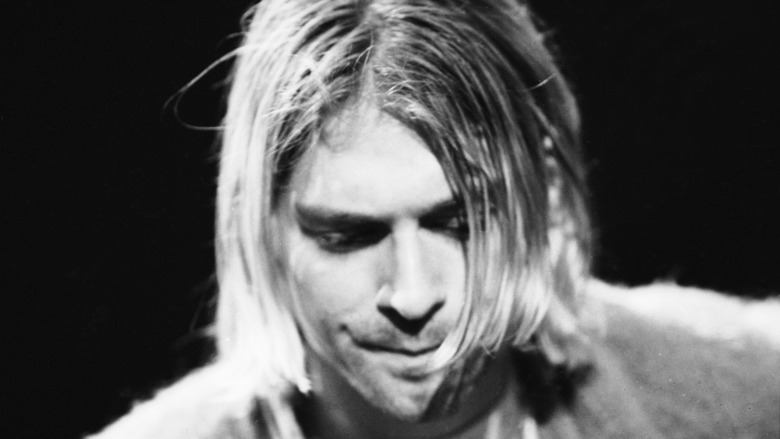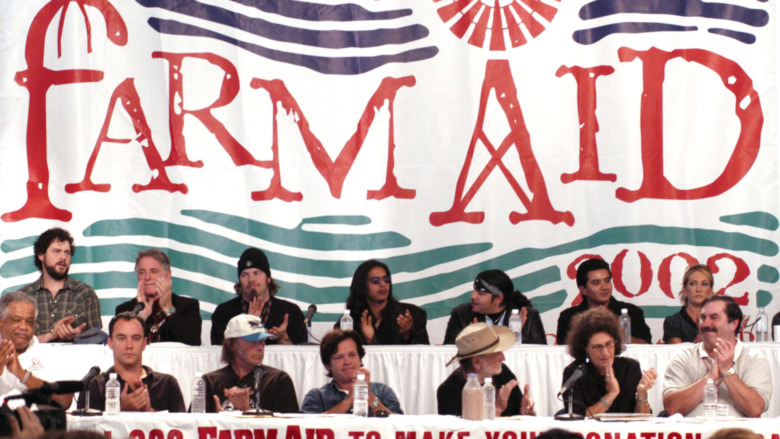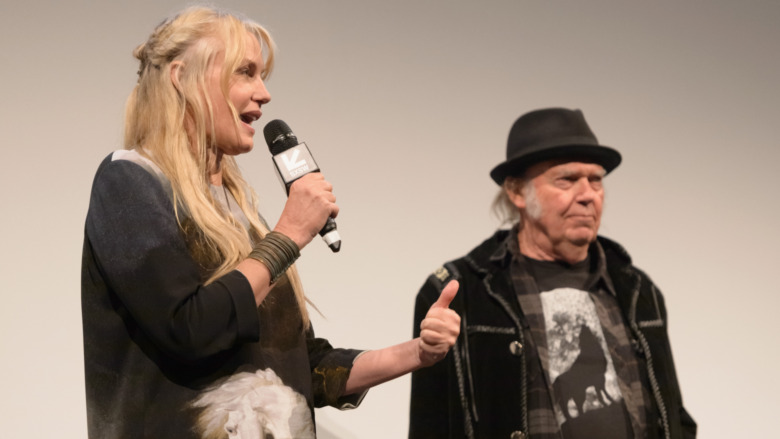The Untold Truth Of Neil Young
In the music industry, finding success, let alone for more than half a century, is almost impossible. Neil Young, therefore, has beaten the odds. Since the Lyndon Johnson administration, Young has been a world-renowned musician. This, in large part, is due to the diverse musical skillset he's developed over the decades.
He writes songs like Bob Dylan, and at the same time, has guitar playing ranks him as one of the best. Rolling Stone ranked him No. 17 on their list of the "100 Greatest Guitarists," ahead of Carlos Santana and Buddy Guy, and No. 34 on their list of the "100 Greatest Artists," ahead of Michael Jackson, Madonna, and David Bowie. His voice can go from loud rocker to soft falsetto to country twang, putting him at No. 37 on the magazine's list of "100 Greatest Singers," ahead of Mariah Carey and Elton John. For more than half a century, Young has left a musical legacy whose length, diversity, and quality, are unrivaled.
Despite this, many aspects of Young's life have remained in the dark. Young famously did not seek out magazine covers, as he discussed in a 1984 interview on Night Flight: "I have other things I'm more interested to do than getting my face on People magazine." In an attempt to shed some light on his life, here is the untold truth of Neil Young.
Neil Young's father was a celebrity
Neil Young wasn't the only famous individual in his family. Per Biography, Neil Percival Young was born on November 12, 1945, in Toronto, Canada, to Edna Young and Scott Young. According to The Canadian Encyclopedia, Scott Young was one of the most distinguished sports journalists in the country's history.
Scott Alexander Young did not begin his career as a sports journalist. As told by CBC, his first job in journalism was with the Winnipeg Free Press before moving on to The Canadian Press, which he worked from 1942 to 1943 as a war correspondent in London during World War II. Scott went on to serve in the Royal Canadian Naval Volunteer Reserves in Europe and the Mediterranean for the rest of the war. After spending three years as the assistant editor at Maclean's magazine, he would spend the next three decades as a popular sports journalist, columnist, and commentator for the Toronto Globe and Mail, the Toronto Telegram, and the CBC.
Scott Young also became a successful author and historian, writing a number of books, short stories, and novels, including Neil and Me, a 1984 biography about his son and watching him rise to superstardom in music. He gave Neil his first musical instrument, a ukulele, shortly before he and his wife divorced. In 1988, Scott Young was inducted into the Hockey Hall of Fame as a journalist. He died in June 2005 at the age of 87.
Neil Young worked with a then-unknown Rick James
Neil Young's musical career has taken him through many different genres, from soft folk and country to blues and grunge rock. Still, R&B isn't a genre most people would think of when discussing Neil Young. Nonetheless, as described in Far Out magazine, Young was a member of an R&B group, The Mynah Birds, early in his music career. The group was fronted by a young Rick James and was on their way to being signed by the most popular label in the US, Motown Records.
By the time Young joined the band, James (known as Ricky James Matthews) was the frontman. Unfortunately, he was also on the run from the law. He was in Canada to avoid being drafted into the US Navy. Already having a string of multiple low-level convictions to his name and not wanting to go to Vietnam, James had fled north.
With Columbia Records, the group released two singles that caught the ear of Motown, which gave the group a deal and a cash advance. However, the money disappeared when the manager got ahold of it. He was fired by the band, and in retaliation, he told the authorities and Motown of James' status. James was soon in US custody, Motown cut off ties to the band, and the group was over. Young said this to Mojo magazine about his musical direction following the breakup: "I moved instead towards acoustic music and immediately became very introspective and musically-inward. That's the beginning of that whole side of my music."
Neil Young asked to be edited out of the Woodstock film
The 1969 Woodstock Music Festival is seen today as the apex of the counterculture movement of the 1960s. As a musician in two of the most famous groups of the counterculture, Buffalo Springfield and Crosby, Stills, Nash, & Young, it made sense that Neil Young would perform with CSN&Y during the festival. But if one watches the film, Young never appears on camera or has his name mentioned.
According to Fandom, the group was still in their infancy when they played Woodstock. While each member had been successful in previous bands (Stephen Stills and Neil Young with Buffalo Springfield, David Crosby with The Byrds, and Graham Nash with The Hollies), Stills said that Woodstock was just the second time the four men had played together as a group for any audience! Still, the set went off without a hitch in the early morning hours of Monday, August 18.
However, on film, Young does not make any kind of appearance during the performance. Even his name is redacted when the band is introduced. Young famously hated all the cameras and told them to stay away from him during the performance, as he discussed in a 2014 appearance on The Howard Stern Show.
Ironically, CSN&Y would cover Joni Mitchell's song about the festival, "Woodstock," the next year on their album Deja Vu (via AllMusic). Young's face and performance finally make an appearance in a 2019 documentary on Woodstock, according to KB Go.
The story behind "The Needle and the Damage Done"
Songwriters have always drawn inspiration for their music from actual events in their lives, and Neil Young is no different in this regard. According to Guitar Noise, one of Young's most well-known songs, "The Needle and the Damage Done," was written for 1972's Harvest, and it has a dark background story.
The song, as told by Songfacts, was written about a former friend and bandmate of Young, Danny Whitten. Whitten was an original member of the band Crazy Horse, who would eventually become Young's backing band. By the beginning of the 1970s, Whitten had become heavily addicted to heroin, a dependency which continued despite multiple interventions. Young ultimately fired Whitten after a bad session where he could not hold his guitar. He gave his friend $50 for rehab and a plane ticket back to Los Angeles. Whitten would fatally overdose on alcohol and valium shortly after reaching LA.
Young later spoke of his friend's death: "I felt responsible. But really there was nothing I could do. I mean, he was responsible. But I thought I was for a long time. Danny just wasn't happy. [...] He was engulfed by this drug. That was too bad. Because Danny had a lot to give."
Activism through songs
Aside from songs based on events in his own life, Young also wrote many protest songs influenced by his political leanings. Young was very influenced by the music of Bob Dylan, calling him "the master" in a 2005 interview with Time, so it made sense that like his hero, he would use his songs to push a political message to his audience.
One of Young's most famous protest songs, "Ohio" (performed as part of Crosby, Stills, Nash & Young) was inspired by a real-life tragedy. On May 4, 1970, National Guardsmen fired live ammunition into a crowd of anti-war protestors on the campus of Kent State University. Four students were killed. According to Ultimate Classic Rock, days after the Kent State Massacre, David Crosby handed Young a copy of Life magazine which showed an image of the gruesome aftermath. Crosby said Young disappeared for a few hours into the woods and returned with the lyrics written and studio time booked. "Ohio," despite being censored by many stations for its political lyrics, became a Top 20 hit and an anti-war anthem.
Young's protest songs span decades. Songfacts says that his 1989 hit "Rockin' in the Free World" was a harsh critique of the George H.W. Bush administration and rising political tensions in the Middle East and Eastern Europe. Young would also show his disdain for George W. Bush in 2006, releasing an entire album, Living with War, about George W. Bush and the War on Terror, Polyphonic explains.
Neil Young's complicated relationship with Crosby, Stills & Nash
Neil Young has a complicated relationship with his early bands. As told by VH1's Legends, in Buffalo Springfield, he refused to play on The Johnny Carson Show and left the band for a brief time before the Monterey Pop Festival. Still, his old partner in Buffalo Springfield, Stephen Stills, would work with Young again in the supergroup Crosby, Stills, Nash & Young.
Legends explains that Young's desire to be a solo artist caused his split with Buffalo Springfield, but it also accidentally created Crosby, Stills & Nash. When Young refused to perform at Monterrey, Stills asked David Crosby to fill in, and the pair connected. The two were introduced to Graham Nash, and the trio became Crosby, Stills & Nash. After their first album in 1969, Atlantic Records president Ahmet Ertegun pushed them to put Young in the band.
Following an album and two tours as part of CSN&Y, Young left to continue his solo career in 1970. Three years later, Young called Nash and Crosby to join him on a tour, and soon, all four men were together. But when the band decided to make an album, Young disappeared. A year later, Young called Stills, desiring to work on a CSN&Y album. However, Nash and Crosby were unable to join for contractual reasons. Despite Crosby and Nash recording vocals, Young and Stills cut their contributions, creating a Stills and Young duo album and angering their old bandmates. And like clockwork, while touring, Young decided to leave, forcing Stills to finish the tour alone.
Neil Young's "beef" with Lynyrd Skynyrd
Lynyrd Skynyrd and Neil Young reached the peaks of their popularity in the 1970s. At the same time, both artists used their songs to criticize each other, which they did in three of the most famous songs of their respective careers.
The images of American racism that hit the national headlines in the 1960s led Young to record two of his most popular songs, "Southern Man" and "Alabama," according to Ultimate Classic Rock. These songs, especially "Alabama," caught the ear of Ronnie Van Zant, the lead singer and songwriter of the Southern rock group Lynyrd Skynrd. Far Out says that Van Zant was a fan of Young but felt his song painted the South with too broad of a brush. His response was "Sweet Home Alabama," which included these lyrics: "Well I heard Mister Young sing about her/Well I heard ol' Neil put her down/Well I hope Neil Young will remember/A Southern man don't need him around anyhow."
Despite what seemed to evidence of a feud, in reality, the two acts were apparently cordial. According to Groovy History, Van Zant wrote his response as a joke, and Young had written the song "Powderfinger" for Skynyrd to record. Unfortunately, Van Zant was one of several band members who died in a plane crash in 1977 before recording "Powderfinger." The band's surviving members have said there was no feud.
Two Beatles were not fans of Neil Young
While Neil Young working as a teenage traveling musician, the Beatles made their way to the United States and launched the musical counterculture of the 1960s. In many ways, the Fab Four paved the way for Young and many others of the era to gain their future success. At the same time, two members of the Beatles, John Lennon and George Harrison, were very critical of Young and his music.
According to Hyper Rust, John Lennon, in a 1980 interview conducted by David Sheff for Playboy, took exception with what he believed was the message in Young's 1977 song, "Hey, Hey, My, My (Into the Black)." "I hate it," he said. "It's better to fade away like an old soldier than to burn out. If he was talking about burning out like Sid Vicious, forget it. I don't appreciate the worship of dead Sid Vicious or of dead James Dean or dead John Wayne. [...] No, thank you. I'll take the living and the healthy."
Lennon would be murdered three months after the interview. Young responded to the criticism two years later, saying he was discussing the spirit of rock 'n' roll and not musicians or individuals themselves.
While Lennon's criticism could be chalked up to mixed messages, nothing can be misinterpreted when it comes to George Harrison's opinion on Young. According to Far Out, when asked by Bob Geldolf, Harrison said, "I'm not a Neil Young fan" and stated that he hated Young's guitar playing.
Neil Young's connection to Kurt Cobain
According to Far Out, similar to how Aretha Franklin is called "The Queen of Soul," Neil Young's music led him to earn the title "The Godfather of Grunge." Some of his songs are considered precursors to the grunge sound of the late 1980s and early '90s, with its dark lyrics and loud and heavy sound production. Unfortunately, Young never had a chance to meet the genre's most famous figure, Kurt Cobain, before the latter's suicide. According to NME, Cobain's death had a large impact on Young.
John Lennon had feared that many would take Young's lyrics in "Hey, Hey, My, My (Into the Black)" as celebrating premature death. The fear came true when Cobain quoted the song in his suicide note: "It's better to burn out than to fade away."
According to Ultimate Classic Rock, Young had tried to reach out to the troubled star, as a mentor from one generation to the next, and upon learning of Cobain's suicide and Young's lyrics in the note, it affected him greatly: "When he died and left that note, it struck a deep chord inside of me. It f*cked with me. I coincidentally, had been trying to reach him. I wanted to talk to him. Tell him only to play when he felt like it." Young's 1994 album, Sleeps With Angels, was reported to have been inspired by Cobain's suicide.
If you or anyone you know is having suicidal thoughts, please call the National Suicide Prevention Lifeline at 1-800-273-TALK (8255).
Neil Young's activism outside of music
Neil Young has never been shy in using his music to push his political opinions. He has also spent a lot of time on the front lines of many political and social movements, from his teen years in Buffalo Springfield to today. According to Farm Aid, Young was one of three musicians, along with John Mellencamp and Willie Nelson, who have organized the long-running concert series every year since 1985.
According to the Calgary Herald, at a press conference before the start of the 2013 concert, Young discussed the trials that American farmers face because of climate change: "The farmers are on the front lines of climate change, and climate change is the issue of the 21st century."
Young began 2020 by officially becoming a citizen of the United States, and he used his newfound citizenship to lambaste President Donald Trump. According to Billboard, Trump began his 2016 presidential campaign by playing Young's song, "Rockin' In The Free World" (despite the song being a critique of the first Bush administration). Young demanded that Trump not use his song. After becoming a citizen, he penned a letter to Donald Trump, with the first line reading, "You are a disgrace to my country."
Bipartisan in his criticism, during the Dakota Access Pipeline Protest at Standing Rock, Young wrote a message to President Obama on Facebook, asking the then-commander-in-chief to stop the "violent aggression" of the police, The Guardian reports.
Neil Young's family life
According to Biography, Neil Young suffered from various health issues early in his life. By 1951, at the age of six, Young was left unable to walk for a time because of the effects of Type 1 diabetes, epilepsy, and polio. While the musician would recover, in part because of his mother's nurturing and his growing love of music, these issues would follow him for the rest of his life.
According to Ultimate Classic Rock, both of Young's sons, Zeke and Ben Young, suffer from severe cases of cerebral palsy. Ben was unable to attend nearby schools because they were not equipped to handle his cerebral palsy. So Neil and his then-wife, Pegi, founded the Bridge School in 1986, to help kids like their son. The school gains funding through a number of benefit concerts Neil and his colleagues in the music world give.
Young met Margaret "Pegi" Morton in 1974. He divorced his first wife and married Pegi in 1978. The couple would divorce in 2014, and Pegi passed away from cancer on New Year's Day in 2019.
After the divorce, Young began a relationship with actress Daryl Hannah. According to USA Today, the couple married in 2018. Their "announcement" was Young referring to Hannah as his wife in a social media post supporting gun control legislation. That same year, the couple collaborated on the film Paradox, written and directed by Hannah and starring Young.
